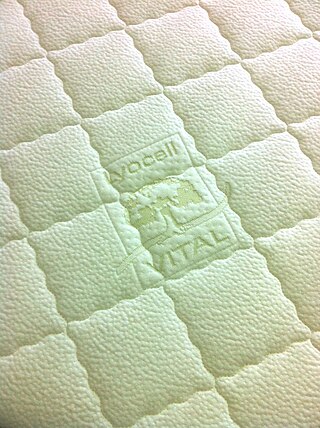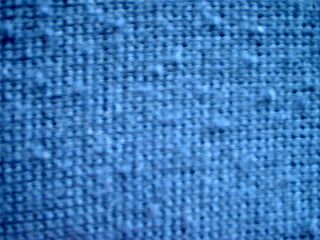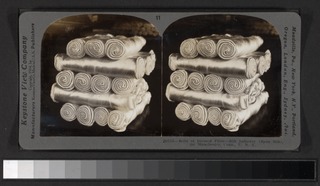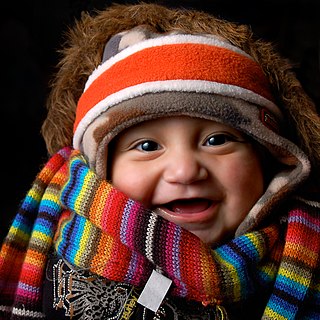Related Research Articles

Textile is an umbrella term that includes various fiber-based materials, including fibers, yarns, filaments, threads, different fabric types, etc. At first, the word "textiles" only referred to woven fabrics. However, weaving is not the only manufacturing method, and many other methods were later developed to form textile structures based on their intended use. Knitting and non-woven are other popular types of fabric manufacturing. In the contemporary world, textiles satisfy the material needs for versatile applications, from simple daily clothing to bulletproof jackets, spacesuits, and doctor's gowns.

Textile arts are arts and crafts that use plant, animal, or synthetic fibers to construct practical or decorative objects.

Velvet is a type of woven tufted fabric in which the cut threads are evenly distributed, with a short, dense pile, giving it a distinctive soft feel. By extension, the word velvety means "smooth like velvet". In the past, velvet was typically made from silk. Today, velvet can be made from linen, cotton, wool and synthetic fibers.

Lyocell is a semi-synthetic fiber used to make textiles for clothing and other purposes. It is a form of regenerated cellulose made by dissolving pulp and dry jet-wet spinning. Unlike rayon made by some of the more common viscose processes, Lyocell production does not use carbon disulfide, which is toxic to workers and the environment. Lyocell was originally trademarked as Tencel in 1982.

Dyeing is the application of dyes or pigments on textile materials such as fibers, yarns, and fabrics with the goal of achieving color with desired color fastness. Dyeing is normally done in a special solution containing dyes and particular chemical material. Dye molecules are fixed to the fiber by absorption, diffusion, or bonding with temperature and time being key controlling factors. The bond between dye molecule and fiber may be strong or weak, depending on the dye used. Dyeing and printing are different applications; in printing, color is applied to a localized area with desired patterns. In dyeing, it is applied to the entire textile.

Textile manufacturing is a major industry. It is largely based on the conversion of fibre into yarn, then yarn into fabric. These are then dyed or printed, fabricated into cloth which is then converted into useful goods such as clothing, household items, upholstery and various industrial products.

Gauze is a thin, translucent fabric with a loose open weave. In technical terms "gauze" is a weave structure in which the weft yarns are arranged in pairs and are crossed before and after each warp yarn keeping the weft firmly in place. This weave structure is used to add stability to fabric, which is important when using fine yarns loosely spaced. However, this weave structure can be used with any weight of yarn, and can be seen in some rustic textiles made from coarse hand-spun plant fiber yarns. Gauze is widely used for medical dressings.
The manufacture of textiles is one of the oldest of human technologies. To make textiles, the first requirement is a source of fiber from which a yarn can be made, primarily by spinning. The yarn is processed by knitting or weaving, which turns yarn into cloth. The machine used for weaving is the loom. For decoration, the process of colouring yarn or the finished material is dyeing. For more information of the various steps, see textile manufacturing.

Textile fibers, threads, yarns and fabrics are measured in a multiplicity of units.
A staple fiber is a textile fiber of discrete length. The opposite is a filament fiber, which comes in continuous lengths. Staple length is a characteristic fiber length of a sample of staple fibers. A fiber is made up of natural substances and is known for being longer than it is wide. It is an essential criterion in yarn spinning, and aids in cohesion and twisting. Compared to synthetic fibers, natural fibers tend to have different and shorter lengths. The quality of natural fibers like cotton is categorized on staple length such as short, medium, long staple, and extra-long. Gossypium barbadense, one of several cotton species, produces extra-long staple fibers. The staple fibers may be obtained from natural and synthetic sources. In the case of synthetics and blends, the filament yarns are cut to a predetermined length.

A singe is a slight scorching, burn or treatment with flame. This may be due to an accident, such as scorching one's hair when lighting a gas fire, or a deliberate method of treatment or removal of hair or other fibres.

In textile manufacturing, finishing refers to the processes that convert the woven or knitted cloth into a usable material and more specifically to any process performed after dyeing the yarn or fabric to improve the look, performance, or "hand" (feel) of the finish textile or clothing. The precise meaning depends on context.

A pill, colloquially known as a bobble, fuzzball, or lint ball, is a small ball of fibers that forms on a piece of cloth. Pill is also a verb for the formation of such balls.
Dimensional stability pertains to a fabric's ability to maintain its initial size and shape even after undergoing wear and care, which is a desirable property. Dimension stability in fabrics or Shrinkage is the change of dimensions in textile products when they are washed or relaxed. The change is always expressed relative to the dimensions before the exposure of washing or relaxing. Shrinkage is also called residual shrinkage and measured in percentage. The major cause of shrinkages is the release of stresses and strains introduced in manufacturing processes. Textile manufacturing is based on the conversion of fiber into yarn, yarn into fabric, includes spinning, weaving, or knitting, etc. The fabric passes through many inevitable changes and mechanical forces during this journey. When the products are immersed in water, the water acts as a relaxing medium, and all stresses and strains are relaxed and the fabric tries to come back to its original state.
Wet Processing Engineering is one of the major streams in Textile Engineering or Textile manufacturing which refers to the engineering of textile chemical processes and associated applied science. The other three streams in textile engineering are yarn engineering, fabric engineering, and apparel engineering. The processes of this stream are involved or carried out in an aqueous stage. Hence, it is called a wet process which usually covers pre-treatment, dyeing, printing, and finishing.

Greige goods are loom state woven fabrics, or unprocessed knitted fabrics. Greige goods undergo many subsequent processes, for instance, dyeing, printing, bleaching, and finishing, prior to further converting to finished goods such as clothing, or other textile products. "Grey fabrics" is another term to refer to unfinished woven or knitted fabrics.

Hand feel is the property of fabrics related to the touch that expresses sensory comfort. It refers to the way fabrics feel against the skin or in the hand and conveys information about the cloth's softness and smoothness. Hand feel is an estimated and subjective property of different fabrics, but nowadays, hand feel could be measured and assessed statistically.

3D textiles are three-dimensional structures made with different manufacturing methods such as weaving, knitting, braiding, or nonwoven, or made with alternative technologies. 3D textiles are produced with three planar geometry, opposed to 2D textiles that are made on two planes. The weave in 2D textiles is perpendicular. The yarn is fed along two axis: length (x-axis) and width (y-axis), while 3D textiles also have a perpendicular weave, but they have an extra yarn with an angular feeding (z-axis) which creates thickness. 3D weaves are orthogonal weave structures, multilayer structures, and angle interlocks. 3D textiles have more manufacturing opportunities, various properties, and a broader scope of applications. These textiles have a wide range of applications, but they are most commonly used where performance is the primary criterion, such as technical textiles. Composite materials, manufacturing is one of the significant areas of using 3D textiles.

Scouring is a preparatory treatment of certain textile materials. Scouring removes soluble and insoluble impurities found in textiles as natural, added and adventitious impurities, for example, oils, waxes, fats, vegetable matter, as well as dirt. Removing these contaminants through scouring prepares the textiles for subsequent processes such as bleaching and dyeing. Though a general term, "scouring" is most often used for wool. In cotton, it is synonymously called "boiling out," and in silk, and "boiling off."
Lisle was a type of finish that was applied to obtain smooth and even yarns, largely employed for goods intended for underwear and hosiery. Yarns made with long-staple fibers such as Egyptian cotton were passed repeatedly and swiftly through gas flames. The action removes the fuzzy and protruding fibers. The finish adds smoothness, gloss, and evenness to the yarn. Most often, yarn done with a lisle finish was referred to as " Lisle yarn." or "Lisle thread." These were plied, high-twisted, gassed combed yarns of long-staple cotton.
References
- 1 2 3 Kadolph, Sara J. (2007). Textiles. Pearson Prentice Hall. p. 334. ISBN 978-0-13-118769-6.
- ↑ Tortora, Phyllis G.; Johnson, Ingrid (2013-09-17). The Fairchild Books Dictionary of Textiles. A&C Black. p. 564. ISBN 978-1-60901-535-0.
- ↑ Adanur, Sabit (1995-10-06). Wellington Sears Handbook of Industrial Textiles. CRC Press. p. 162. ISBN 978-1-56676-340-0.
- 1 2 3 Mahall, Karl (2012-12-06). Quality Assessment of Textiles: Damage Detection by Microscopy. Springer Science & Business Media. p. 93. ISBN 978-3-642-55645-6.
- 1 2 Karmakar, S. R. (1999-11-02). Chemical Technology in the Pre-Treatment Processes of Textiles. Elsevier. p. 56. ISBN 978-0-08-053947-8.
- ↑ Blackburn, Richard (2005-11-30). Biodegradable and Sustainable Fibres. Elsevier. p. 143. ISBN 978-1-84569-099-1.
- ↑ Indian Textile Annual & Directory. Eastland Publications. 1992. p. 81.
- ↑ Technology of the Textile Industry, U.S.S.R. Textile Institute. 1968. p. 158.
- ↑ Textile Trends. Eastland Publications. 1999. p. 17.
- ↑ Bhatia, S. C. (2017-10-26). Pollution Control in Textile Industry. CRC Press. ISBN 978-1-351-37305-0.
- ↑ Egyptian Journal of Chemistry. National Information and Documentation Centre. 2007. p. 263.
- ↑ The Indian Textile Journal. Indian Textile Journal Limited. 2011. p. 85.
- ↑ Gupta, Vijai G. (2016-11-15). New and Future Developments in Microbial Biotechnology and Bioengineering: Microbial Cellulase System Properties and Applications. Elsevier. p. 169. ISBN 978-0-444-63515-0.
- ↑ Carr, C. (2012-12-06). Chemistry of the Textiles Industry. Springer Science & Business Media. p. 263. ISBN 978-94-011-0595-8.
- ↑ "Cotton - Technology". 2011-09-02. Archived from the original on 2011-09-02. Retrieved 2023-08-13.